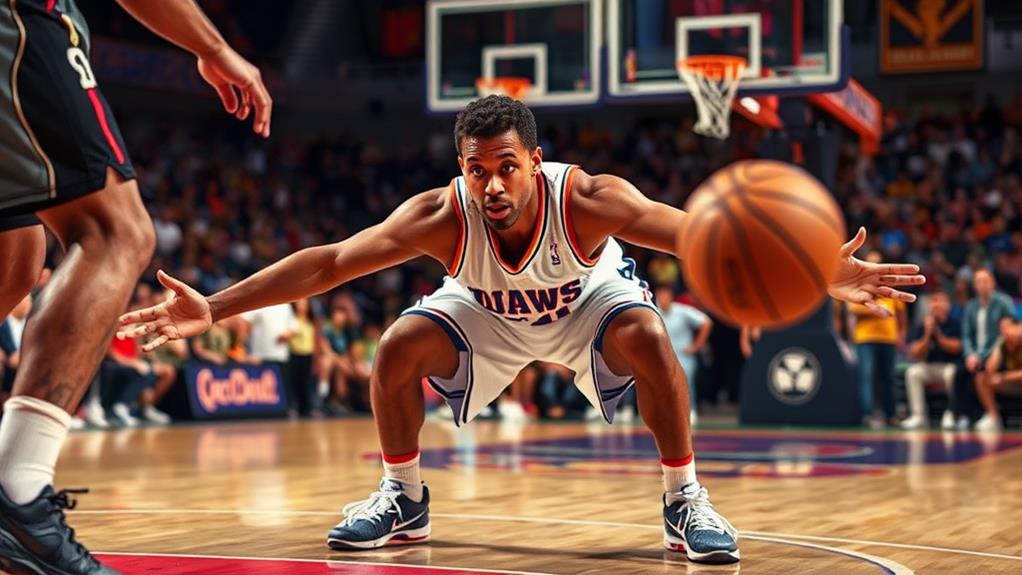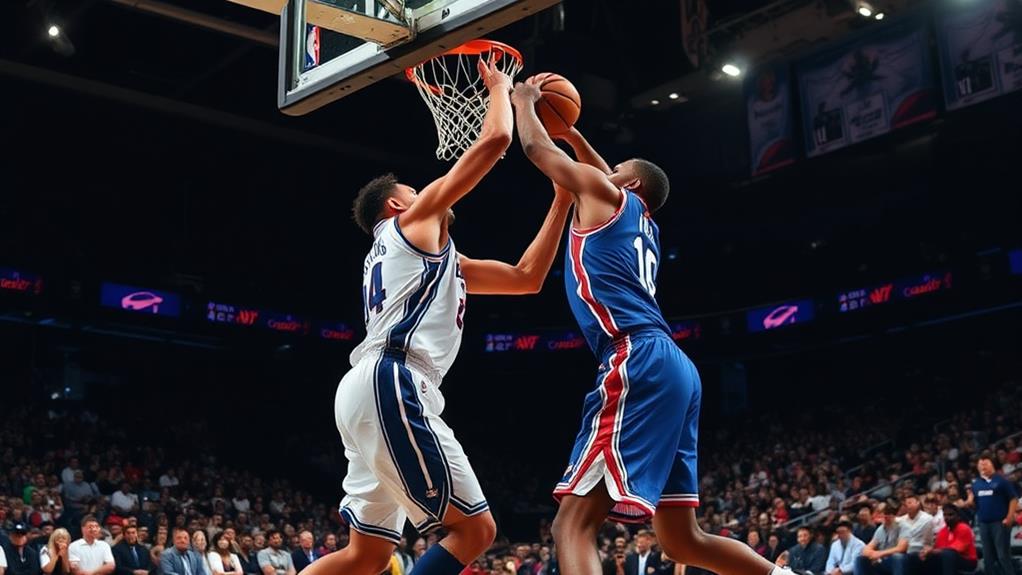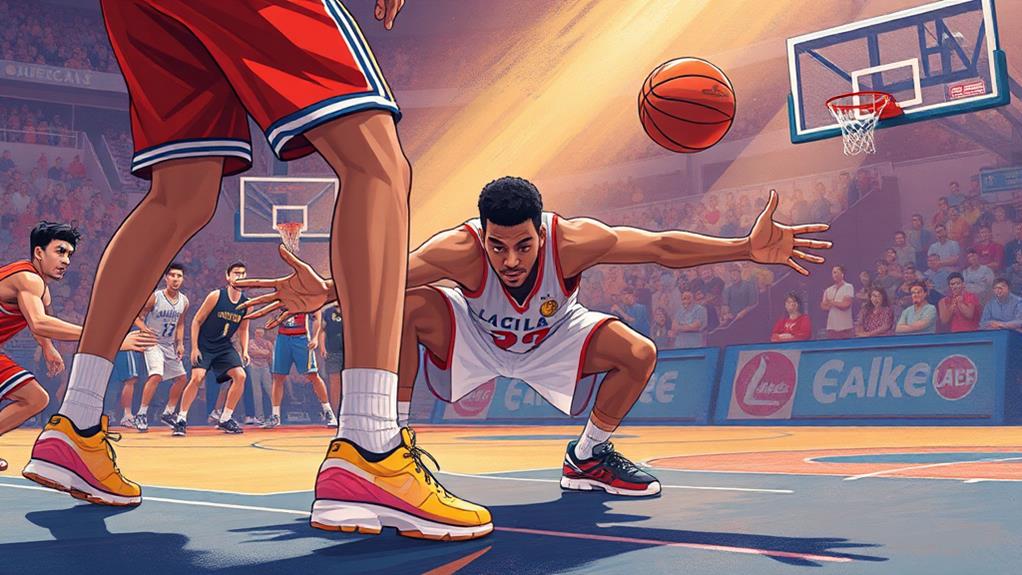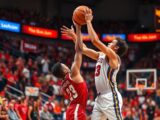
Boxing Out: A Key Skill for Rebounding in Basketball
October 14, 2024Boxing out is essential for improving your rebounding skills in basketball. It helps you establish proper positioning between your opponent and the basket, greatly increasing your chances of securing the ball. Start by making contact with the nearest opponent as the shot goes up. Maintain an athletic stance to enhance your balance and leverage. Use vocal cues like "SHOT!" to alert your teammates, fostering better teamwork. Remember, consistent practice of boxing out techniques can transform your effectiveness on the court. To truly master this skill, there's so much more you can discover about executing it effectively.
Importance of Boxing Out
Boxing out plays an essential role in basketball, and mastering this skill can greatly enhance your team's performance. When you box out, you're effectively positioning yourself between your opponent and the basket, markedly increasing your chances of securing rebounds.
Adopting an athletic stance is critical; it allows you to maintain balance and leverage, making it easier to fend off opponents and grab that ball. Utilizing data-driven strategies can further optimize your positioning and effectiveness in securing rebounds.
Whether you're a taller player or on the smaller side, strategic positioning can lead to success in rebounding. Remember, size isn't everything; it's about how you use your body to create space. By consistently practicing boxing out, you not only improve your individual skills but also foster teamwork. Coordination and communication with your teammates become essential, especially when it comes to making those critical rebounds.
Neglecting boxing out can lead to missed opportunities, turning potential wins into losses. It's important to instill this skill into your game. By focusing on boxing out, you'll help control the tempo of plays and maintain possession, ultimately driving your team toward success on the court.
Communication Strategies
To box out effectively, you need to communicate with your teammates. Yelling cues like "SHOT!" not only alerts everyone to prepare for a rebound but also boosts overall team awareness.
This vocal communication is essential for establishing team coordination, which enhances your ability to secure rebounds. When you promote vocal communication, you enhance coordination on the court, making it easier to secure those vital rebounds.
Importance of Vocal Cues
Effective communication on the basketball court hinges on vocal cues, which play an essential role in enhancing team dynamics. When you yell "SHOT!", it serves as a crucial vocal cue that alerts your teammates to prepare for potential rebounds. This simple shout can greatly improve overall awareness on the court, enabling players who mightn't have a clear line of sight on the shot to react promptly.
Promoting vocal communication fosters teamwork and coordination, making it easier for everyone to execute effective boxing out strategies. The use of vocal cues guarantees that all players are focused and ready to react, considerably increasing the chances of securing both offensive and defensive rebounds.
Enhancing Team Awareness
Three key communication strategies can markedly enhance team awareness on the basketball court. By fostering clear and vocal interactions, you'll set your team up for better rebounding opportunities. Here's how to get started:
- Yell "SHOT!": This vital cue alerts your teammates to prepare for rebounds. It shifts their focus and raises overall court awareness.
- Vocalize Intentions: Let your teammates know your plans, whether you're going for the ball or boxing out. This helps those distracted to redirect their attention, especially when you raise your right hand to signal your move.
- Use Verbal Signals: Consistently communicate during plays. This creates a culture of proactive rebounding, making it a collective effort.
- Anticipate Movements: By clearly communicating shot attempts, you can help everyone anticipate opponents' movements, improving positioning strategies.
When you implement these strategies, you're not just enhancing your individual game, but also fostering teamwork and coordination essential for securing both offensive and defensive rebounds.
Promoting Coordination on Court
Promoting coordination on the court is essential for maximizing your team's rebounding effectiveness. One of the most effective communication strategies is yelling "SHOT!" This simple call alerts your teammates to prepare for a rebound, greatly increasing their chances of securing possession after a missed shot.
Effective communication fosters heightened awareness among players who mightn't have a direct view of the shot, allowing them to react quickly and position themselves for boxing out.
When you and your teammates engage in proactive communication, you not only enhance individual readiness but also build a collective habit of boxing out. Calling out the shot helps everyone focus on their responsibilities, leading to better coordination of movements and strategies for both defensive and offensive rebounding opportunities.
As you anticipate contact with your opponent, consistent communication guarantees players are prepared to execute their boxing out techniques efficiently. This teamwork creates a proactive mindset, ultimately improving overall team performance.
Positioning Techniques

Boxing out in basketball relies heavily on proper positioning techniques to secure rebounds. To effectively box out and establish your presence close to the basket, follow these essential strategies:
- Identify and Contact: Immediately after a shot, identify the nearest opponent and close the distance to establish physical contact. This is vital for effective boxing out, especially when utilizing smart defensive tactics to limit scoring opportunities.
- Athletic Stance: Maintain an athletic stance with wide feet, bent knees, and extended arms. This enhances your balance and strength against the opponent's movements.
- Maintain Position: Shuffle left or right as needed while keeping your body low. This prevents the opponent from easily pushing you away from the basket.
- Leverage: Utilize a reverse pivot and create a wide stance with your back against the opponent. This maximizes leverage and makes it more challenging for them to maneuver.
Always keep contact using your hands to gauge their movement. However, avoid excessive holding to guarantee compliance with game rules.
Creating Space for Rebounds
Creating Space for Rebounds
After mastering positioning techniques, the next step is creating space for rebounds. To do this effectively, you need to back down your opponent, using your body to push them away from the basket. This technique not only enhances your positioning but also disrupts their ability to jump for the ball. Engaging physically with your opponent is vital; it's how you really take your game to the next level.
As you develop these skills, remember that increased diversity in athletic representation can enhance competition and broaden perspectives on the court.
Developing an awareness of your opponent's movements is essential. By anticipating their actions, you can react swiftly, which opens opportunities for your teammates to grab the rebound if you can't secure it yourself. Practicing this technique helps you feel their presence, even without direct visual cues, leading to more successful rebounding situations.
Remember to maintain a low, wide stance. This position increases your stability and leverage, making it harder for opponents to maneuver around you.
Steps to Execute Boxing Out

To successfully execute boxing out, you need to focus on your positioning and leverage. Understanding the importance of teamwork and positioning can enhance your effectiveness on the court, much like how total players and team composition contribute to success in soccer.
Here are four steps to help you master this vital skill:
- Close the Distance: Get close to your opponent and maintain an arm's length for ideal leverage and control. This guarantees you can react quickly to their movements.
- Establish Contact: Place your right hand on the opponent's right hip while stepping through with your right foot. Perform a reverse pivot with your left foot to create solid contact.
- Create a Barrier: Achieve a wide stance with your back against the opponent. This solid barrier makes it tough for them to maneuver around you.
- Monitor Movements: Maintain body contact and use your hands to feel your opponent's movements without grabbing them. This positioning keeps you ready to secure the rebound.
Consistent practice of these techniques will enhance your muscle memory, positioning, and overall effectiveness in boxing out during games.
Team Dynamics in Boxing Out
Effective team dynamics are vital in boxing out, as regular communication and awareness among players can greatly enhance your chances of securing rebounds. To succeed, each player must understand their assignments and the positioning of their teammates and opponents, reflecting the importance of teamwork and communication in defensive plays.
Assigning specific players to box out opponents during shots is essential; this focused effort can considerably increase your likelihood of winning the rebound battle.
When two players collaborate to box out a single opponent, they create a stronger barrier, making it much tougher for the opposing player to grab the board after missed shots. Consistently practicing boxing out as a team not only fosters better communication but also improves your collective awareness on the court.
Encouraging players to yell "shot!" when a shot goes up is an excellent way to prompt immediate awareness. This shout signals teammates to engage proactively in boxing out, thereby amplifying your chances of securing possession after missed shots.
Conclusion
Incorporating effective boxing out techniques can greatly boost your team's rebounding success. Did you know that teams that consistently box out grab 30% more rebounds than those that don't? By communicating clearly, positioning yourself strategically, and creating space, you not only improve your chances of securing the ball but also enhance team dynamics on the court. Embrace boxing out as a fundamental skill, and watch your team's performance soar as you dominate the boards.


